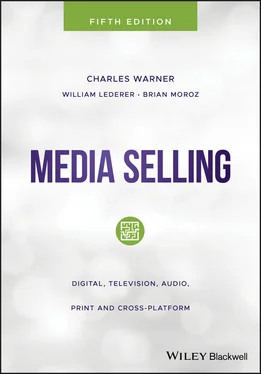Set moderately difficult but attainable objectives. If objectives are reasonable, challenging, and attainable, they are motivating. If people perceive objectives to be unattainable, they will not work hard to achieve them. It is important to give time and thought to setting realistic, attainable objectives so that when you accomplish them you will feel successful.
Demanding, like attainable, is related to difficulty. As seen in Figure 4.1, an objective has to be not only attainable but also sufficiently demanding to be challenging. High achievers are particularly motivated by demanding goals that challenge them. For high achievers the big payoff is the conquest and feeling like a winner, more so than any money that might be involved.
Consistent with company goals
Individual objectives should be consistent with company objectives and goals. For example, broadcast salespeople sometimes work at cross‐purposes to their sales departments by concentrating on selling rates that are too low or by “cherry picking” inventory, which means only selecting the highly rated advertising slots or special low‐price offers to sell. Such practices would be inconsistent with an overall company goal of maximizing revenue, for example.
Under control of the individual
Another seemingly self‐evident criterion for sound objectives states that they must be under the control of the individual. Instead of setting a revenue objective, set objectives for the number of calls you will make or for the number of presentations you will give. These are activity objectives. Too often, the concept of setting activity objectives is overlooked, especially by beginning salespeople. For example, objectives that would not be under the control of salespeople would be “to increase revenue next month by 25 percent.” But what if that next month’s ratings on your television station went down 30 percent or last month was the bottom month in a yearlong advertising slowdown. You cannot control ratings or the general economy; you can only control how hard you work and your own activities.
Your goals and objectives must be deadlined; they must have a due date. Without clear deadlines, goals and objectives become amorphous. Here is an example of some objectives a radio salesperson might write: “Next month I will increase my average rates from last month by 10 percent; I will increase the number of prospecting calls I make in the average week from 10 to 15; and I will make 25 percent more face‐to‐face presentations.” These goals are measurable, attainable, demanding, consistent with company goals, under the control of the person, and deadlined. Notice the phrase “a radio station salesperson might write.” Objectives that are not written down are worthless because they are merely intentions. A further way to increase your commitment to your objectives is to give your manager a copy of your written objectives.
Remember to keep your objectives flexible. If they are carved in stone and unchangeable, your objectives can lose their motivating effect particularly if they turn out to be unreasonable because of economic conditions, because of a shift in competitive positioning, or because of a change in your organization’s priorities or strategy.
Take Full Responsibility for Your “Cycle of Success”
High achievers set demanding objectives and goals, enjoy solving problems, take calculated risks, want immediate feedback on their performance, and take personal responsibility for their own “cycle of success” (see Figure 4.2).
The cycle of success is an ongoing cycle of ever‐more demanding objectives and goals that lead to ever‐increasing success. But just as the AESKOPP formula for success was multiplicative in the sense that if any of the seven AESKOPP elements were not present, success could not be achieved, so it is with the cycle of success in that all of the elements are inextricably linked.

Figure 4.2 The Cycle of Success
The cycle is your cycle. You own it and must take full responsibility for keeping it moving. What drives it, the motor for this cycle, is your dream. Remember the words of Walt Disney earlier in this chapter: If you can dream it, you can do it.
You cannot win an Olympic gold medal if you do not or cannot dream of winning one. Dennis Waitley in his inspirational book, Empires of the Mind , writes about the dreams of accomplished and successful people. Waitley suggests that writing a personal mission based on your dream can help you realize it. Write it down, keep it in your wallet, backpack, or purse, and let it drive your cycle of success.
1 What do the various letters in AESKOPP mean?
2 Do all of the seven AESKOPP elements have to be present for successful selling?
3 What are some of the core competencies of Skills?
4 What are the two types of Preparation?
5 How can a salesperson use the core competencies rating system to improve performance?
6 Name two ways a sales manager can use the core competencies rating system.
7 What is an attitude?
8 Which comes first, attitude or performance? Why?
9 What is the difference between a goal and an objective?
10 What are the six criteria for sound objectives?
11 What are the four elements in the cycle of success?
First, rate yourself on all of the core competencies, make a list of the five you need to work on most, and then assign yourself some monthly learning goals. For example, “to improve my market knowledge by reading Chamber of Commerce material and Census data next month.”
Second, choose a task, such as writing a term paper or a sales presentation, or an activity, such as dating, and write a MADCUD objectives statement that will help you complete the task or activity successfully.
Last, write a BHAG for yourself – several years in the future – and then write a personal mission statement that will help you focus on and achieve your BHAG, your dream.
1 Drucker, Peter F. 1954. The Practice of Management. New York: Harper & Row.
2 Collins, James C. and Porras, Jerry. 1994. Built to Last: Successful Habits of Visionary Companies. New York: Harper Business.
3 Colvin, Geoff. 2008. Talent Is Overrated: What Really Separates World‐Class Performers for Everybody Else. New York: Portfolio.
4 Garfield, Charles A. with Bennett, Hal Zina. 1984. Peak Performance: Mental Training Techniques of the World's Greatest Athletes. New York: Warner Books.
5 Gerstner, Louis V. Jr. 2002. Who Says Elephants Can’t Dance? Inside IBM’s Historic Turnaround. New York: Harper Business.
6 Gladwell, Malcolm. 2008. Outliers: The Story of Success. New York: Little, Brown and Company.
7 Johnson, Spencer and Wilson, Larry. 1984. The One Minute Sales Person. New York: William Morrow.
8 Locke, Edwin A. 1966. “The ubiquity of the technique of goal setting.” Behavioral Science, Vol. II.
9 Locke, Edwin A. and. Bryan, J.F. 1967. “Goal setting as a means of increasing motivation.” Journal of Applied Psychology, Vol. 51.
10 Locke, Edwin A. 1968. “Toward a theory of task motivation and incentives.” Organizational Behavior and Human Performance, Vol. 3.
11 Locke, Edwin A., Cartledge, Norman, and Kerr, Claramae S. 1970. “Studies in the relationship between satisfaction, goal setting and performance.” Organizational Behavior and Human Performance, Vol. 5.
Читать дальше













